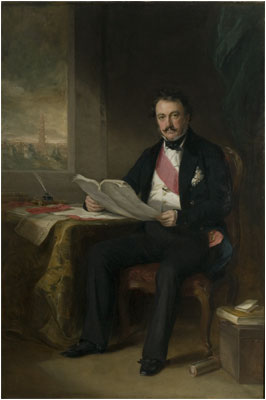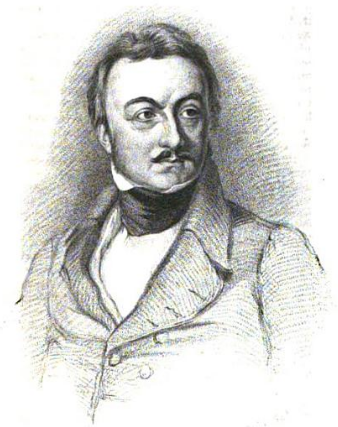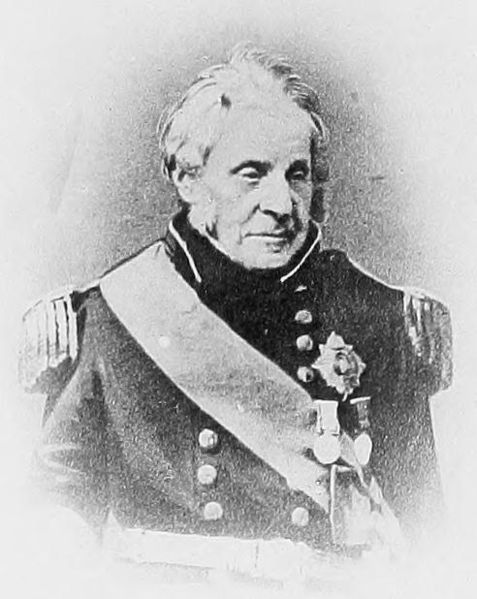<Back to Index>
- 1st Governor of Hong Kong Lieutenant General Henry Pottinger, 1789
- Commander - in - Chief, East Indies and China Station Admiral of the Fleet William Parker, 1781
PAGE SPONSOR


Lieutenant General The Rt. Hon. Sir Henry Pottinger, 1st Baronet, GCB, PC (Chinese: 砵甸乍; 3 October 1789 – 18 March 1856), was an Anglo - Irish soldier and colonial administrator who became the first Governor of Hong Kong.
Henry Pottinger was born in County Down, Ireland, in 1789. He was the fifth son of Eldred Curwen Pottinger, Esq., of Mount Pottinger, County Down, and his wife Anne, who was the daughter of Robert Gordon, Esq., of Florida House in the same county. They had three daughters and eight sons. Eldred Pottinger was his nephew. Henry studied at the Belfast Academy, today known as Belfast Royal Academy.
In 1804, he went to India to serve in the army and explored the lands between the Indus and Persia, traveling in disguise as a Muslim merchant and studying local languages, under the orders of Sir John Malcolm. In 1806, he joined the British East India Company and in 1809, he fought in the Mahratta war as a lieutenant then rising to the rank of colonel after his dangerous expedition from Nushki (Belujistan) to Isfahan (Central Persia). This expedition was funded by the West Indian Company to map and research hitherto unstudied regions of Belujistan and Persia because of concerns about India being invaded by French forces. Pottinger later became Resident Administrator of Sindh in 1820. He later held the same post in Hyderabad.
In 1820, he married Susanna Maria Cooke who in 1831 gave birth to their son, William Frederick who would go on to become notorious for his run-ins with bushrangers as Inspector of Police in New South Wales in Australia. Their second son, Henry, was born on 10 June 1834 and died on 18 October 1909.
He was created a baronet when he returned to England in 1839.
Pottinger accepted Foreign Secretary Lord Palmerston's offer of the post of envoy and plenipotentiary in China and superintendent of British trade, thus replacing Charles Elliot. In 1841, when Pottinger was sent to China, Palmerston instructed him to "examine with care the natural capacities of Hong Kong, and you will not agree to give up that Island unless you should find that you can exchange it for another in the neighborhood of Canton, better adapted for the purposes in view; equally defensible; and affording sufficient shelter for Ships of War and Commerce". On 4 November 1841, Palmerston's successor Lord Aberdeen wrote to Pottinger that he had doubts over Hong Kong's acquisition since it would incur administrative expenses, and complicate relations with China and other nations.
After Pottinger led a navy to defeat Yishan at Humen, he negotiated the terms of the Treaty of Nanking (1842), which ended the First Opium War and ceded Hong Kong Island to the United Kingdom. Pottinger became the second administrator of Hong Kong (1841 – 1843) and the first Governor of Hong Kong (1843 – 1844). When he forwarded the treaty to Aberdeen, Pottinger remarked, "the retention of Hong Kong is the only point in which I have intentionally exceeded my modified instructions, but every single hour I have passed in this superb country has convinced me of the necessity and desirability of our possessing such a settlement as an emporium for our trade and a place from which Her Majesty's subjects in China may be alike protected and controlled."
On 26 April 1843, the Governor's residence (Former French Mission Building) was robbed.
On 26 June 1843, he was appointed to become the Chief Commander of the British troops stationed in Hong Kong.
During his very short tenure, Pottinger established executive and legislative chambers, with one discussing political affairs and one designing legal codes. However, the chambers did not convene often, and this gave Pottinger wide ranging powers to decide on policy.
Towards the end of his tenure, Pottinger lost the support of the local British merchants and was isolated. He left on 7 May 1844.
During his governorship, Hong Kong became the major port for trading opium in China.
Pottinger became a member of the Privy Council in 1844, and became Governor of the Cape Colony in 1847 and also of Madras in the same year. In 1851, he was promoted to the rank of lieutenant general.
He died in retirement in Malta in 1856.
- Pottinger Street in Central, Hong Kong Island
- Pottinger Peak on Hong Kong Island near Siu Sai Wan
- Pottinger Gap between Pottinger Peak and Mount Collinson
- Pottinger Battery, at Devil's Peak, Hong Kong
- Pottingers Entry off High Street in Belfast, Northern Ireland
- Pottinger House, Belfast Royal Academy, his former school, named a house in his honor.
- Mount Pottinger in East Belfast
- Pottinger constituency in Parliament

Admiral of the Fleet Sir William Parker, 1st Baronet, GCB (1 December 1781 – 13 November 1866), was a Royal Navy officer. He was born in Almington, Staffordshire, England. He was not related to the previous Admiral Sir William Parker. His father, George Parker, was the second son of Sir Thomas Parker, who had been Lord Chief Baron of the Exchequer. Sir Thomas Parker's nephew and son - in - law (by marriage to his daughter Martha) was John Jervis, 1st Earl of St Vincent.
William Parker entered the Royal Navy in February 1793 as a captain's servant on the HMS Orion, serving under Captain John Thomas Duckworth. The Orion was part of the Channel fleet under Lord Howe and took part in the Battle of The Glorious First of June. When Captain Duckworth was assigned to another ship, Leviathan, Parker followed him, and sailed with him to the West Indies where Duckworth appointed him acting lieutenant of the frigate Magicienne. In May 1798 he was appointed to the Queen, flagship of Sir Hyde Parker, and on 1 May 1799 became acting captain of the Volage. During the next few months he cruised in the Gulf of Mexico and the coast of Cuba.
In 1800 he returned to England and then spent nearly a year with the blockade fleet off Brest. He became post captain in October 1801. In November he assumed command of HMS Amazon, which he commanded for nearly 11 years. He was attached to the fleet under Admiral Lord Nelson and accompanied the fleet to the West Indies. The Amazon was then sent on a cruise westward and therefore missed the Battle of Trafalgar. She was later attached to a squadron under Sir John Borlase Warren, participating in the capture of the French ships Marengo and Belle Poule at the Action of 13 March 1806. Parker was almost constantly on the move with the Amazon, mainly along the coast of Spain and Portugal, until January 1812 when the ship was paid off.
Parker purchased Shenstone Lodge near Lichfield, where he lived for the next 15 years. In 1827, however, he returned to sea as captain of HMS Warspite, and acted in 1828 as senior officer off the coast of Greece. In December that year he was appointed to command the royal yacht. On 22 July 1830 he was promoted to the rank of rear admiral and in April 1831 was appointed second in command of the Channel Squadron, under Sir Edward Codrington. In September 1831 he was detached on an independent command on the Tagus, aboard Asia where he went to protect British interests during the Portuguese Civil War. When he returned to England he was appointed one of the Lords of the Admiralty. He left the Admiralty in 1841, and was appointed commander - in - chief of the East Indies and China Station. Parker sailed for Hong Kong and assumed command of the squadron on 10 August 1841. The British proceeded to capture Amoy, Ningpo, Woosung and Shanghai, ending with the seizure of Chinkiang and closing the entrance to the Grand Canal on 21 July 1842.
Parker was appointed GCB in 1843, a good - service pension in 1844 and a baronetcy in 1841. In November 1841 he had been appointed Vice Admiral and in 1845 was Commander - in - Chief, Mediterranean Fleet. In May 1846, because of his knowledge of Portugal and its politics, he was given the additional command of the Channel Squadron while still remaining in charge of the Mediterranean. He was briefly (for a week) First Naval Lord in July 1846 but gave up the role due to ill health.
In 1852 he attained the rank of Admiral and returned to England. He served as Commander - in - Chief, Plymouth from 1854 to 1857. He continued to be active, serving as a consultant on a variety of projects. In 1863 he became an Admiral of the Fleet. He died on 13 November 1866 from complications from bronchitis. He was buried in his parish churchyard near his home at Shenstone Lodge, and a monument to his memory was erected in Lichfield Cathedral.
In 1810 he married Frances Anne Biddulph; they had two sons and six daughters.